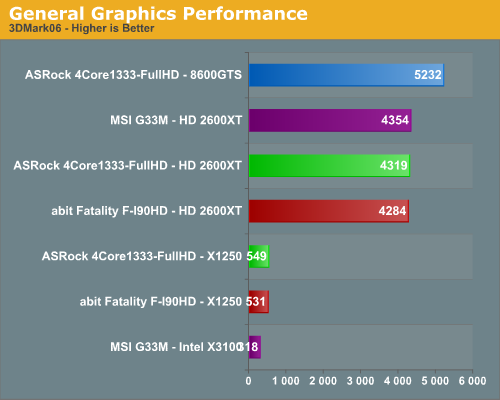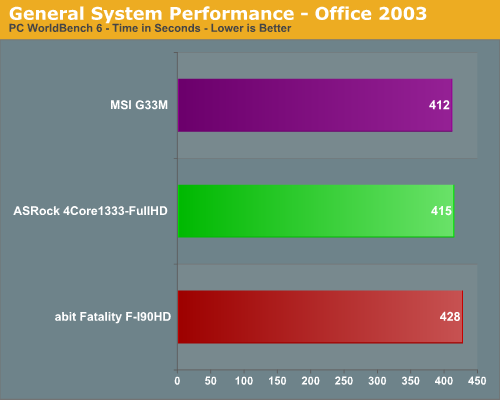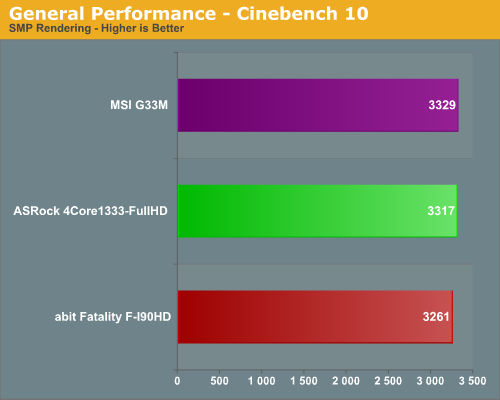µATX Part 1: ATI Radeon Xpress 1250 Performance Review
by Gary Key on August 28, 2007 7:00 AM EST- Posted in
- Motherboards
Synthetic Graphics Performance
The 3DMark series of benchmarks developed and provided by Futuremark are among the most widely used tools for benchmark reporting and comparisons. Although the benchmarks are very useful for providing apples-to-apples comparisons across a broad array of GPU and CPU configurations they are not a substitute for actual application and gaming benchmarks. In this sense we consider the 3DMark benchmarks to be purely synthetic in nature but still very valuable for providing consistent measurements of performance.

In our first test, the G33 makes for a great showing against the X1250 offerings. So we are being a bit sarcastic in that announcement as we consider these results to be anything but great considering it is the later part of 2007. The G33 platform like our X1250 platforms could not complete the Shader Mark 3.0 tests since it is not supported on this chipset. The X1250 did exceed the G33 in the CPU tests. In fact, the CPU test is where the X1250 shined in this test, almost to the point of making us wonder if this test really has any relevance at this point.
General System Performance
The PCMark05 benchmark developed and provided by Futuremark was designed for determining overall system performance for the typical home computing user. This tool provides both system and component level benchmarking results utilizing subsets of real world applications or programs. This benchmark is useful for providing comparative results across a broad array of Graphics subsystems, CPU, Hard Disk, and Memory configurations along with multithreading results. In this sense we consider the PCMark benchmark to be both synthetic and real world in nature while providing consistency in our benchmark results.

The margins are very close in the PCMark05 results with the G33 platform showing a minor advantage over the X1250 platforms due to better storage system performance results. While this benchmark is designed around actual application usage, we will see if these results mirror our application testing.
The Office 2003 test from the PC WorldBench 6.0 benchmark test suite features a number of test scripts that simulate general office tasks in Access, PowerPoint, Excel, and Word.

These tests consistently favored the Intel G33 chipset due to improved memory bandwidth and slightly lower latencies which are important in this series of applications. The ASRock board scores about 4% better than the abit board and this pattern will continue throughout our testing regimen.
Rendering Performance
We are using the Cinebench 10 benchmark as it tends to heavily stress the CPU subsystem while performing graphics modeling and rendering. Cinebench 10 features two different benchmarks with one test utilizing a single core and the second test showcasing the power of multiple cores in rendering the benchmark image. We utilize the standard multiple core benchmark demo and default settings.

We see the Intel G33 chipset basically out-muscling the AMD X1250 equipped abit board with a minimal improvement over the ASRock board. This test indicates the strength of the ASRock implementation of the X1250 in the fact that the X1250 can certainly stand toe to toe with the G33, at least against the business oriented implementation from MSI.
The 3DMark series of benchmarks developed and provided by Futuremark are among the most widely used tools for benchmark reporting and comparisons. Although the benchmarks are very useful for providing apples-to-apples comparisons across a broad array of GPU and CPU configurations they are not a substitute for actual application and gaming benchmarks. In this sense we consider the 3DMark benchmarks to be purely synthetic in nature but still very valuable for providing consistent measurements of performance.

In our first test, the G33 makes for a great showing against the X1250 offerings. So we are being a bit sarcastic in that announcement as we consider these results to be anything but great considering it is the later part of 2007. The G33 platform like our X1250 platforms could not complete the Shader Mark 3.0 tests since it is not supported on this chipset. The X1250 did exceed the G33 in the CPU tests. In fact, the CPU test is where the X1250 shined in this test, almost to the point of making us wonder if this test really has any relevance at this point.
General System Performance
The PCMark05 benchmark developed and provided by Futuremark was designed for determining overall system performance for the typical home computing user. This tool provides both system and component level benchmarking results utilizing subsets of real world applications or programs. This benchmark is useful for providing comparative results across a broad array of Graphics subsystems, CPU, Hard Disk, and Memory configurations along with multithreading results. In this sense we consider the PCMark benchmark to be both synthetic and real world in nature while providing consistency in our benchmark results.

The margins are very close in the PCMark05 results with the G33 platform showing a minor advantage over the X1250 platforms due to better storage system performance results. While this benchmark is designed around actual application usage, we will see if these results mirror our application testing.
The Office 2003 test from the PC WorldBench 6.0 benchmark test suite features a number of test scripts that simulate general office tasks in Access, PowerPoint, Excel, and Word.

These tests consistently favored the Intel G33 chipset due to improved memory bandwidth and slightly lower latencies which are important in this series of applications. The ASRock board scores about 4% better than the abit board and this pattern will continue throughout our testing regimen.
Rendering Performance
We are using the Cinebench 10 benchmark as it tends to heavily stress the CPU subsystem while performing graphics modeling and rendering. Cinebench 10 features two different benchmarks with one test utilizing a single core and the second test showcasing the power of multiple cores in rendering the benchmark image. We utilize the standard multiple core benchmark demo and default settings.

We see the Intel G33 chipset basically out-muscling the AMD X1250 equipped abit board with a minimal improvement over the ASRock board. This test indicates the strength of the ASRock implementation of the X1250 in the fact that the X1250 can certainly stand toe to toe with the G33, at least against the business oriented implementation from MSI.










22 Comments
View All Comments
Sargo - Tuesday, August 28, 2007 - link
Nice review but there's no X3100 on Intel G33. http://en.wikipedia.org/wiki/Intel_GMA#GMA_3100">GMA 3100 is based on much older arhitechture. Thus even the new drivers won't help that much.ltcommanderdata - Tuesday, August 28, 2007 - link
Exactly. The G33 was never intended to replace the G965 chipset, it replaces the 945G chipset and the GMA 950. The G33's IGP is not the GMA X3100 but the GMA 3100 (no "X") and the IGP is virtually identical to the GMA 950 but with higher clock speeds and better video support. The GMA 950, GMA 3000, and GMA 3100 all only have SM2.0 pixel shaders with no vertex shaders and no hardware T&L engine. The G965 and the GMA X3000 remains the top Intel IGP until the launch of the G35 and GMA X3500. I can't believe Anandtech made such an obvious mistake, but I have to admit Intel isn't helping matters with there ever expanding portfolio of IGPs.Here's Intel's nice PR chart explaining the different IGPs:
http://download.intel.com/products/graphics/intel_...">http://download.intel.com/products/graphics/intel_...
Could you please run a review with the G965 chipset and the GMA X3100 using XP and the latest 14.31 drivers? They are now out of beta and Intel claims full DX9.0c SM3.0 hardware acceleration. I would love to see the GMA X3000 compared with the common GMA 950 (also supported in the 14.31 drivers although it has no VS to activate), the Xpress X1250, the GeForce 6150 or 7050, and some low-end GPUs like the X1300 or HD 2400. A comparison between the 14.31 and previous 14.29 drivers that had no hardware support would also show how much things have increased.
JarredWalton - Tuesday, August 28, 2007 - link
I did look at gaming performance under Vista with a 965GM chipset in the http://www.anandtech.com/mobile/showdoc.aspx?i=306...">PC Club ENP660 review. However, that was also tested under Vista. I would assume that with drivers working in all respects, GMA X3100 performance would probably come close to that of the Radeon Xpress 1250, but when will the drivers truly reach that point? In the end, IGP is still only sufficient for playing with all the details turned down at 1280x800 or lower resolutions, at least in recent titles. Often it can't even do that, and 800x600 might be required. Want to play games at all? Just spend the $120 on something like an 8600 GT.IntelUser2000 - Wednesday, August 29, 2007 - link
It has the drivers at XP.
JarredWalton - Wednesday, August 29, 2007 - link
Unless the XP drivers are somehow 100% faster (or more) than the last Vista drivers I tried, it still doesn't matter. Minimum details in Battlefield 2 at 800x600 got around 20 FPS. It was sort of playable, but nothing to write home about. Half-Life 2 engine stuff is still totally messed up on the chipset; it runs DX9 mode, but it gets <10 FPS regardless of resolution.IntelUser2000 - Wednesday, August 29, 2007 - link
I get 35-45 fps on the demo Single Player for the first 5 mins at 800x600 min. Didn't check more as its limited.E6600
DG965WH
14.31 production driver
2x1GB DDR2-800
WD360GD Raptor 36GB
WinXP SP2
IntelUser2000 - Tuesday, September 11, 2007 - link
Jarred, PLEASE PROVIDE THE DETAILS OF THE BENCHMARK/SETTINGS/PATCHES used for BF2 so I can provide equal testing as you have done on the Pt.1 article.Like:
-What version of BF2 used
-What demos are supposed to be used
-How do I load up the demos
-etc
R101 - Tuesday, August 28, 2007 - link
Just for the fun of it, for us to see what can X3100 do with these new betas. I've been looking for that test since those drivers came out, and still nothing.erwos - Tuesday, August 28, 2007 - link
I'm looking forward to seeing the benchmarks on the G35 motherboards (which I'm sure won't be in this series). The X3500 really does seem to have a promising feature set, at least on paper.Lonyo - Tuesday, August 28, 2007 - link
Bioshock requires SM3.0.